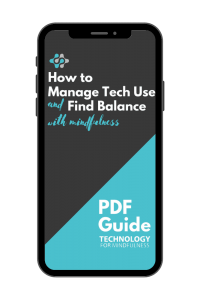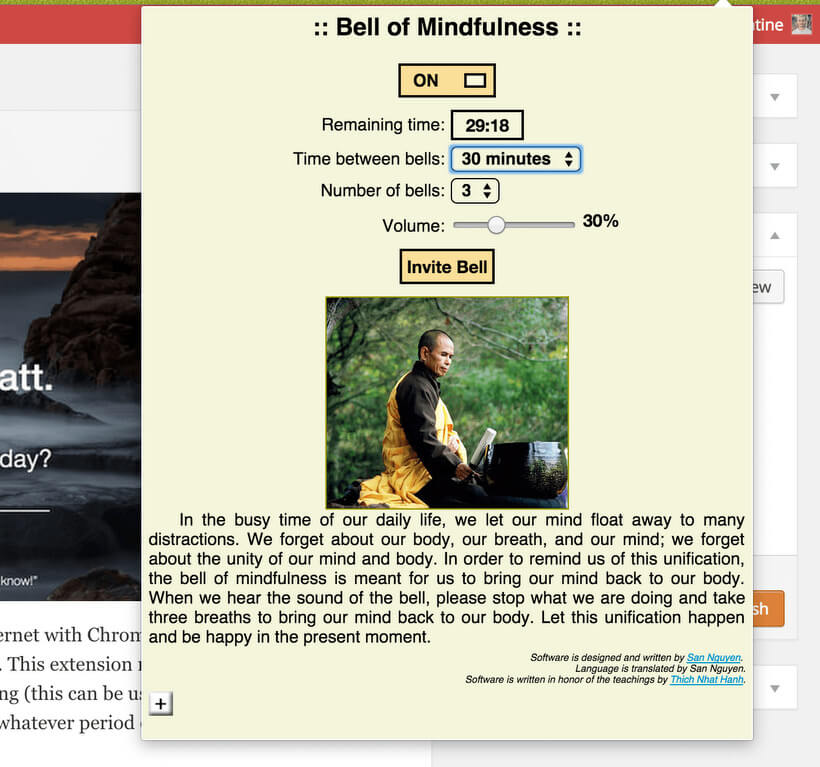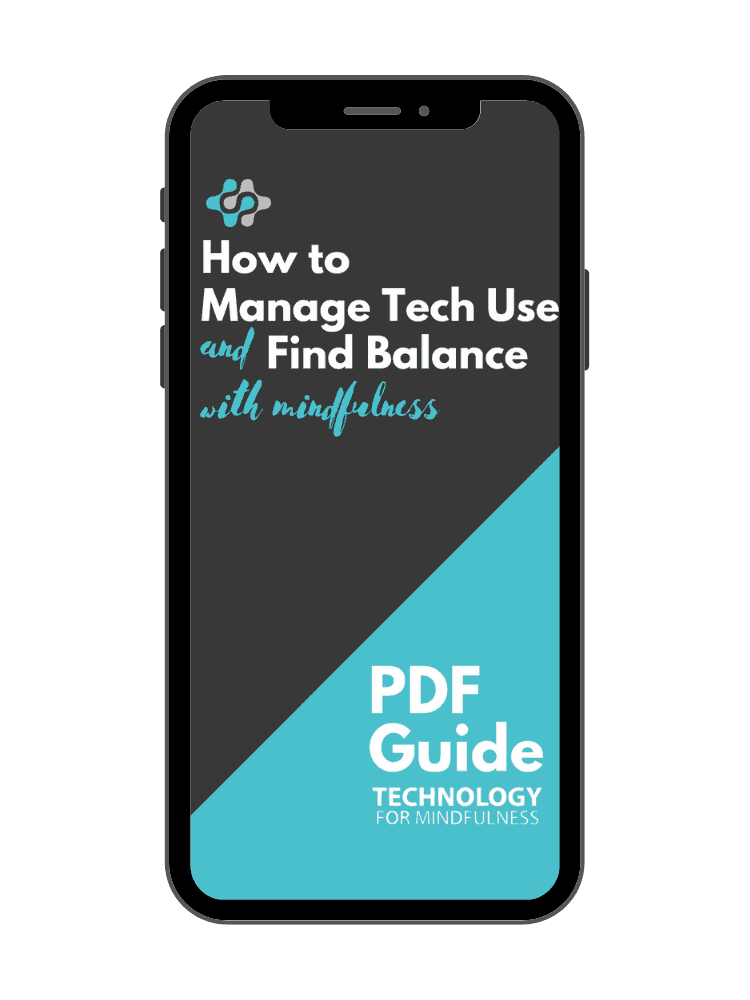Mindfulness tips can be found in abundance… but they’re not necessarily all that useful.
Take a sec to run a Google search and you’ll be hit with a barrage of tips for mindfulness practice like:
- “Concentrate on your breath”
- “Smell the flowers”
- “Notice what you’re doing”, and even…
- “Meditate”
It’s not that these tips are wrong they’re just… not helpful.
Not to mention, they entirely ignore the topic of how our tech use affects that mindfulness practice.
Chances are, you’ve heard about mindfulness somewhere already and may have even tried a guided meditation or a short practice on your own.
You may have heard that through regular mindfulness practice, people find themselves happier and healthier, including everything from:
- An improved ability to focus
- A better quality of relationships, and
- The ability to better manage emotional and psychological pain
You might have also heard that mindfulness meditation helps manage stress and conditions that can arise from chronic thought patterns caused by it such as anxiety and depression.
Regular mindfulness training can also help reduce the habit of ruminating and change how you react to negative emotions.
(Psst: If you haven’t tried mindfulness before and you want to get your feet wet with some simple mindfulness practices, try our guide on finding balance and managing tech use with simple mindfulness practices below:

Find balance, take back your life
Learn how to manage tech use, reduce stress, and find balance with our free PDF guide on simple mindfulness techniques.
However, mindfulness, and meditation in general, can feel really strange if you’re just starting out and it can be hard to know if you’re doing it right.
That’s why we’ve put together this comprehensive list of mindfulness tips, not only to be super helpful to beginners (I would have loved to know many of these when I was just starting out) but also helpful to seasoned meditators and mindfulness practitioners as well who are looking to take their practice further.
24 Mindfulness Tips for Beginners: Tips for Bringing Balance to Daily Life with Mindfulness
The mindfulness tips below are separated into five major categories, including formal meditation practice, mindfulness in daily life, mindfulness and tech habits, mindfulness at work, and creating an environment that supports mindfulness.
Use the links in the table of contents below to jump straight to the section you’re most interested in or keep scrolling to check them out one-by-one.
Here are 24 tips for mindfulness practice to help you make the most of your practice whether you’re a beginner or even a long-time practitioner.
Table of Contents
- Mindfulness tips for…
- Sitting in meditation
- Being mindful in daily life
- Managing tech use with mindfulness
- Bringing mindfulness into the workplace
- Creating an environment that promotes mindfulness
- Additional mindfulness tips and resources
- Frequently asked questions
Mindfulness tips for sitting in meditation
Formal meditation is the foundation of mindfulness practice.
It’s difficult to have a healthy mindfulness practice without sitting in meditation for at least a few minutes a day, whether that’s in your bedroom shortly after waking or in your office on your lunch break or in your car.
So, here are some tips for improving your formal mindfulness meditation practice:
1. Understand that you are not your thoughts
The first few times you sit in meditation, it can be a bit shocking, or at the very least surprising, just how many thoughts– especially negative thoughts– run in and out of your mind within just a few short minutes. No wonder Buddha dubbed it the monkey mind.
They might not be extraordinarily negative, perhaps just anxiety or stress about something you’re waiting to hear about or worry about the future. However, these thoughts, when taken in mass, can paint a stark picture.
Your thoughts don’t define you, no matter how convincing they are. What goes on in your mind is not you nor is it real, simply what you think about yourself and the world around you.
Work regularly sitting in meditation to separate yourself from these thoughts and observe them without intentional judgment (sometimes judgment comes up without us trying, and that’s okay).
If you’re just starting meditation, it can be a bit hard to understand what this kind of separation might feel like, but when it starts to happen it’s a liberating realization that can really help reduce self-judgment.
2. Be kind to yourself
On a similar note, regular mindfulness practice can make you aware of the self-criticism you have living within you, and as a result, make you wonder if there’s something wrong with you.
PSA: There’s nothing wrong with you and most people think exactly what you’re thinking (so did I).
When you sit in meditation, go easy on yourself. Most of us are filled with difficult emotions, which could be stress, anxiety, sorrow, envy, disappointment, confusion, loneliness, or one of the other countless emotions we experience throughout our life.
Kicking yourself over these emotions is natural, but it won’t help. So, it’s a habit you should work to break over time as best as you can manage.
Notice these feelings, even the feelings about the feelings, and work hard to see and to understand that these emotions aren’t who you are, but the result of your experience.
With self-kindness, you can help heal much of that.
3. Make it important (Goal: A consistent meditation practice)
In my experience, having surveyed hundreds of practitioners, sticking to a consistent meditation practice is the biggest challenge in the beginning.
The reality is, we’re all so absorbed with our daily lives that making something like sitting in a quiet corner of your bedroom each morning a priority is a hard sell for your likely overworked and overwhelmed mind.
It’s constantly in, “Need to take care of X today,” or “Have to get X done,” mode. So, to convince it to take time to sit and follow your breathing, while you might be aware of the benefits, is hard to truly convince your mind to prioritize.
However, the truth is, if you don’t prioritize sitting in meditation, the craziness of daily life will swallow it up and you might never get back on it.
It works like any other habit in life: you need to tell yourself, “This is important to me and I’m going to prioritize it on the same level as other things that are important to me,” and stick to that in order to develop a consistent meditation habit.
The good news is, if you do this, it becomes much easier to establish a consistent practice.
4. Practice patience (results can take a while)
Everyone is different, and few activities make this more apparent than with meditation. Some people experience immediate and intense benefits from mindfulness meditation practice.
Others experience minor benefits that increase over time. And others have a hard time with the practice, feeling like it’s helping but having such a hard time while they’re sitting that they really don’t know if it’s helping or not.
With that said, it’s important to talk with a professional if you have any form of mental illness, as sometimes anxiety and other conditions can worsen with meditation.
However, that aside, it takes time to see the most significant benefits of mindfulness meditation.
You have to be willing to dive deep into your mind and rest there for long periods of time over months or even years to touch those parts of yourself that you may have hid away from due to the intensity of the pain or trauma associated with it.
So enjoy the practice as an effective tool for managing stress and difficult emotions now, but be patient and see it as a long-term practice to get the most from it.
5. Don’t forget to have fun with it
Some simple? It is. Sound obvious? That too.
So, why am I mentioning it? Because as obvious as it sounds, most people forget to enjoy their practice when they start meditating.
They get so hung up on doing the practice right, taking it seriously, worrying about the feelings and thoughts coming up during their sessions that they forget to enjoy the practice for what it’s worth.
Some days it will be easier to sit than others, it’s true. Some days you feel perfectly peaceful and refreshed after sitting, other times you feel arguably feel worse.
Generally, that’s just a reflection of what’s going on inside, as your session touched on those feelings that are hovering around in your subconscious and brought them a bit further to the surface.
However, most of the time the practice can be really enjoyable. So, do your best not to forget to have fun with meditation.
Mindfulness tips for being mindful in daily life
Mindfulness is unique to other forms of meditation because it’s not restricted to the meditation cushion.
In fact, it’s not just possible to be mindful throughout daily life, it offers most of the same benefits as sitting in meditation as well as some unique benefits all to its own.
Practicing mindfulness in daily life can help you better manage your emotions, respond to stress, improve your focus, and be present for your loved ones and all that’s important to you in your life.
Here are tips for being mindful in daily life:

1. Walking is the easiest “everyday” practice to adopt
Walking meditation has been practiced by Buddhists for hundreds, if not thousands of years.
It’s the second most common form of mindfulness meditation practice only behind formal sitting meditation.
We walk everywhere: to our kitchen, car, office, back to our car, into our home, into the store, out from the store– you get the idea. Each and every one of these examples is a moment where you can tap into mindfulness.
Notice the feeling of solid earth beneath your feet, of the wind on your face, of your legs bending and working one step at a time, and the rest of your body moving.
Walking meditation is done exactly like following your breath except your steps are your point of concentration. Just as with your in-breath and out-breath, you focus on the lifting and placing down of each left and right step.
If you’re looking to bring mindfulness into your daily life, walking meditation is one of the easiest first practices to pick up.
2. But driving meditation is probably the easiest to pick up quickly
Walking meditation is a personal favorite, but when you’re walking your mind is often racing with the task at hand. After all, when you’re walking you’re in transition, going from one place to another.
However, for many of us, our morning and especially evening drive are some of the few moments in our day when we have very little if any real interruptions.
Driving naturally lends itself to mindfulness as you’re constantly moving your hands across the steering wheel, feeling the wheel itself and moving it back and forth rhythmically.
It’s also the perfect environment for a quiet moment as you can drive with the windows up and the music off.
Alternatively, if you don’t drive home and instead take a train or something similar, you can put your headphones on and practice on your ride home in much the same way, even listening to a guided meditation if you choose.
3. Practice mindfully “checking-in”
A mindful check-in is a simple but useful practice. It’s essentially just the act of regularly turning inward to notice what’s going on within you: what thoughts, feelings, and sensations you’re feeling.
This is the exact same thing you do when you meditate, the only difference is you’re doing it for 60 seconds or less in the middle of your day.
It’s a quick check-in that helps you keep tabs on how you’re feeling throughout your day that then promotes further mindfulness between the practice itself.
You can use an app like the Bell of Mindfulness Chrome extension, which allows you to set a timer for every 30, 45 or 60 minutes to automate this. Otherwise, it’s difficult to remember until you’ve established the habit.
4. Notice when you’re zoning out
Another simple practice is to notice when you zone out.
We all do it, whether it’s sitting at our desk in the middle of the day thinking about the ball game from last night or when you go into autopilot for twenty minutes driving on your way home every night.
Each of these is times when you can acknowledge you were zoning out and simply notice what’s going on in your head and in your body.
Mindfulness tips for managing tech use
Conversations around mindfulness often ignore the unmistakable influence that technology is having on our lives, attention, and our general well-being.
The truth is, while technology offers many benefits, it can impede mindfulness practice. The good news is, it can also enhance it as well, if you know what you’re doing.
Use these tips for managing your tech use with mindfulness and for greater mindfulness.
Become a notification ninja to manage external interruptions
If we were to narrow down the greatest issue with modern tech, the incessant notifications that interrupt our day could very well be top-of-the-list.
Notifications are persistent and difficult to resist, having been designed to induce a powerful conditioned emotional response from us over time.
They serve as a big barrier to mindful living as they condition the very opposite behavior: automatic, unintentional action that conditions anxiety and promotes distraction.
So, use these tips to help you better manage notifications, reduce distractions, improve focus, and promote more mindfulness throughout your day:
1. Manually turn notifications off for chunks of time
For Apple, this is Do Not Disturb, Windows it’s Quiet Hours, and Android it’s Notifications.
For example, you could turn off notifications for meetings, during a one or two hour period while you’re doing intense work or playing with your kids, or while driving.
2. Schedule notifications when needed
Using the same settings sections above, schedule various types of personal, work, and other relevant notifications in their respective time blocks.
For example, personal texts can be set to go off only during your lunch hour and after work while work-related notifications during work hours.
That way, notifications are less likely to veer your off-task and better organize your day based on specific efforts organized into relevant time blocks.
3. Reconfigure your email for intentional, uninterrupted work
Email can be just as bad as notifications in some cases, especially if you’re frequently sending emails throughout the day.
To work more intentionally and promote more mindfulness throughout your workday especially, consider using an app like Inbox When Ready for Gmail.
The app allows you to hide your inbox during specified hours so that it doesn’t distract you if you need to compose an email.
To support this, also set email notifications to only go off during specified time blocks scheduled in advance.
For example, you might schedule to check email at 4 times during your day: when you first get into the office, after your lunch break, at the end of the workday, and two hours before bed.
Between that time, your inbox is shut off and you’re not receiving notifications, reducing distractions and further promoting a mindful tech environment.
If there are certain contacts you need to receive messages for as soon as they come through, depending on your device, you can configure “VIP” contacts (this is available with Apple/iOS currently): a select few contacts that you allow to receive notifications for.
Alternatively, or in addition to this, you can set an auto-responder that tells people your schedule for responding to messages, so they know when to expect a response from you.
4. Wait 3 seconds before unlocking your smartphone
One of the simplest but most powerful tech-related mindfulness practices is to simply wait a few seconds before unlocking your smartphone.
Why wait? The point is to take those three seconds to turn your attention inward to notice what thoughts, feelings, and sensations arise as you’re picking up your device.
Smartphone and app companies have worked hard to design their hardware and apps in a way that makes it very difficult to resist checking your phone when it pings.
Powerful emotional triggers are being tugged at each time your phone sounds, so you may often be interacting with your phone in a way that’s not all that healthy.
Those pings could set off a kind of FOMO anxiety that makes your mind race and stress every time your phone sounds.
Instead, you want to interact with your devices in a way that’s more intentional and self-aware.
Stopping each time you go to unlock your phone, even if only for a few seconds, can start to clue you in about how your smartphone use is affecting your mind and mental health in general.
5. Use a tracking app to observe digital behavior
When you practice mindfulness, your “job” is to simply observe everything going on in your mind.
Over time, that observation will help calm the mind and give you important insights that can further improve your mental health.
In the same way, you can use a tracking app on your smartphone or computer like Timing to observe your digital behavior to glean similar insights.
Tips for bringing mindfulness into the workplace
We spend a large portion of our lives at work.
The problem, when it comes to mindfulness practice, is work is a whole different beast that can swallow our attention and spit us out eight (or more) hours later, exhausted and confused as to where the day went and really what we did with our time.
However, there are some great tips and practices you can implement that are more specific to the workplace which can help enhance your mindfulness practice while working and allow you to work in a more focused, intentional, and relaxed way.
Here are tips for bringing mindfulness into the workplace:
1. Take frequent breaks
Workdays often fly by from beginning to end without us even realizing when happened.
It’s often even harder to be mindful during work than at home, where things slow down.
At least, to some degree.
That’s why you need to be especially vigilant to bring mindfulness to work. The first and easiest way to do this is simply to schedule regular breaks throughout your day, something that apps like Calm, Focusatwill, and DoNothing are perfect for.
For thirty seconds to one minute, stop at your computer or wherever you’re at and simply follow your breath.
Alternatively, you can use guided meditations from apps like InsightTimer (you can check out our guided meditations on the app here) to guide you through a short practice on a slightly longer break.
Also, you can do a body scan practice or use music or play a game to give your mind a linguistic break if you’re typically doing the same set of tasks for work such as reading and writing.
2. Do one thing at a time
Multitasking is a myth, but that hasn’t kept people from trying.
We feel good when we “multitask”, like we’re getting more done, even though… we really aren’t.
The problem is, we’re not just fooling ourselves, we’re actually harming our ability to produce quality work and live mindfully by keeping the mind in this state of constant dispersion.
The cure? Do one thing at a time.
Maybe not so surprising, but if you haven’t truly practiced this, it’s hard to understand just how powerful an effect it can have on your work and life as a whole.
The easiest way to set your day up to focus on one thing at a time is to schedule your day in blocks.
For the first hour or two each day, focus on the hard stuff or some easy wins so you can get that out of the way and feel a sense of momentum that can extend into the rest of the day.
Other tips to help you focus on one thing more often include disabling messaging while you’re driving and using full-screen mode more often.
3. Set and stick to intentions in groups
For most of us, work involves constantly interacting with other people.
To fully bring mindfulness into the workplace, you need to bring mindfulness to how you interact with them.
One of the ways you can do that is to set and stick to your intentions when in groups. That means when you’re meeting with teammates, be highly purposeful about how you conduct the meeting in every way.
For example:
- Never run a meeting without a clear agenda
- Then, stick to that meeting’s agenda like gospel
- Make sure every attendee has the agenda well in advance
- Every decision at a meeting is assigned clearly to a person who will have ultimate responsibility for executing that decision
- And every decision you make has a deadline
- Also, make sure every goal or task has a clear plan for executing it
These tips might stretch well beyond simply being mindful at work, but they’re important in terms of the bigger picture.
It’s not enough just to meditate and be mindful as you walk or drive for a few minutes each day, you need to take that same mindset and apply it to all areas of your life to truly live mindfully.
4. Practice mindful speech and deep listening
Listening is a critically important professional skill. Unfortunately, it’s one very few of us are very good at.
Whether you’re an owner or CEO, manager, or individual contributor, learning how to listen mindfully and speak with more thought and intention are powerful tools that can improve the quality of your relationships. In fact, this stretches well beyond the workplace.
Take time to really listen to what your colleagues, boss, and team members have to say. Listen to their words without assumption or judgment, just as you do in your personal mindfulness practice, and really think about what they’re saying. It’s rare that someone really takes the time to listen, so people appreciate it and will remember it in the future.
Then, on the speech side, take time to think about your words before responding. Don’t let emotions guide your responses.
Instead, be mindful of and about how you respond in any situation and sit on a response if you feel you’re too angry or generally worked up about something to respond mindfully.
Further reading: For more on mindfulness at work, reading out complete guide: Mindfulness at Work: Practical Tips for Busy Professionals.
Tips for creating an environment that promotes mindfulness
It’s easy to try and implement a regular mindfulness practice into your life as it is now.
However, chances are there are some things in place in your life now that will impede that practice and affect your well-being in the process.
That’s why it can be really valuable to invest some time into creating an environment that promotes greater mindfulness, as it will make it easier to be mindful throughout your entire life.
Here are tips for creating an environment that promotes mindfulness:
- Have a designated meditation space: This could be a corner in your bedroom or really anywhere else.
- Use sound/music to promote mindfulness: With apps like Focusatwill, Calm, and Noisli.
- Use images/pictures to promote mindfulness: Calm has great wallpaper examples, but any positive emotion-inducing image of nature can help with this, especially large photography placed in your office, bedroom, living room, smartphone or other device wallpaper, etc.
- Use a distraction-free word processor: Ommwriter, JDarkroom, Writeroom, Hanxwriter
- Block access to distracting web sites and apps: SelfControl, AntiSocial, FocusMe
- Watch how multiple devices interact: Do you get the same notifications on your smartphone and tablet/computer? Does your smartphone often interrupt you when you’re on your computer working? Pay attention to how your devices conflict with one another in a way that promotes distraction and reaction as opposed to mindfulness and intentional action.
More mindfulness tips & resources
Mindfulness is a life-long practice that can influence every area of your life.
Ultimately, there are no rules or specific guidelines you need to follow. However, learning as much as you can from current teachers and other long-time practitioners is always a good route for continued learning.
At the end of the day, try these tips out and keep the ones that work for you, while discarding the ones that either don’t apply or work for you and your life.
To further help you on your journey of growth through mindfulness and more intentional tech use, check out these additional resources:
- The Best Free Mindfulness Meditation Apps in 2019
- Mindfulness at Work: Practical Tips for Busy Professionals
- 47 Mindfulness Quotes to Help You Hit the Pause Button
- How to Improve Focus: A Comprehensive Guide to Improving Focus in Work and Life
And while you’re at it, take a listen at this recent episode of the TFM podcast with Ted Meissner, where he and TFM founder Robert Plotkin talk about how tech can enhance mindfulness practice:

Frequently Asked Questions
How can I practice mindfulness throughout the day?
Being mindful in everyday life can be tough, especially considering we’re so conditioned to move about our day on a kind of half-autopilot.
However, it is possible to bring mindfulness into your daily life, by doing things such as:
- Taking regular breaks during work to practice mindful breathing (set a timer, so you don’t forget!)
- Going for a mindful walk during your lunch break
- And practice mindful listening when conversing with friends, colleagues, and family
How do I start being mindful?
To start practicing mindfulness, take 5 minutes in the morning, during your work break, or at night before bed and follow your breath, counting each inhale and exhale as 1 up to a 10 count, starting the count over any time you notice yourself get distracted.
You can also practice mindful walking to and from your car or as you’re entering or exiting the store or any other location during errands.
To learn some simple mindfulness practices you can use to start bringing greater balance to your daily life and better manage your tech use, check out our free guide below.
How do I get better at mindfulness?
Mindfulness is like anything else; with practice, you’ll get better at being mindful both while sitting in meditation and going about your everyday life.
The mindfulness tips throughout this guide will help you not only improve your mindfulness practice but also live more mindfully and intentionally, but for those looking to take things a step further, check out Robert’s Insight Timer courses and guided meditations here.












